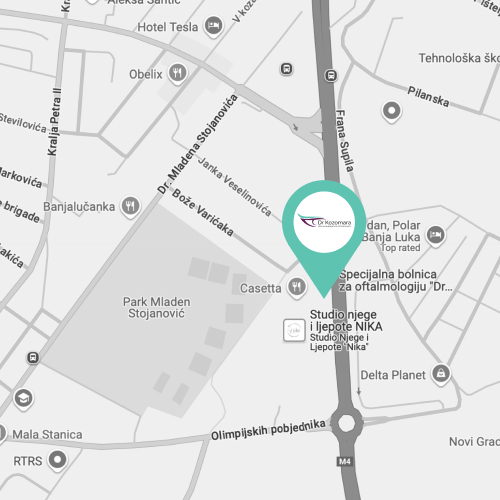Iskusite slobodu jasnog vida
Pogledajte kako LASIK mijenja ne samo vaš vid, već i vaše samopouzdanje, udobnost i svakodnevni život, donoseći novi osjećaj slobode
Iskusite slobodu jasnog vida bez naočala
Nakon LASIK-a, više nećete morati nositi naočale. Zaboravite na zamagljivanje, klizanje i nelagodu tokom aktivnosti poput treninga, joge, ili sportova na otvorenom. Uživat ćete u 100% vidu0 bez ikakvih neugodnosti, što će vam omogućiti da u potpunosti uživate u aktivnom načinu života bez ograničenja.
Povećajte svoje samopouzdanje
Bez naočala, vaše samopouzdanje će porasti u svakodnevnim aktivnostima i društvenim događajima. Prigrlićete svoj novi izgled i uživati u miru koji donosi jasan vid i nova nezavisnost.
Živite punim plućima svaki dan
Zamislite da svoj dan započnete uranjanjem u svoje zadatke bez muke s naočalama. Bilo da radite, vježbate ili se sastajete s prijateljima na ručku, prolazite kroz svaku aktivnost s lakoćom i samopouzdanjem. Svaki trenutak je lakši, omogućavajući vam da u potpunosti uživate u danu sa osjećajem slobode i radosti.
Prigrlite novog sebe
Prijatelji i porodica će primijetiti pozitivnu promjenu kod vas. Vidjeće vaše samopouzdanje i slobodu kako blistate dok živite bez naočala. Vaša energija i sreća će inspirisati druge, a vaš novi izgled će odražavati vašu živahnu ličnost, čineći vas pristupačnijim.
Iskusite slobodu jasnog vida
Pogledajte kako LASIK mijenja ne samo vaš vid, već i vaše samopouzdanje, udobnost i svakodnevni život, donoseći novi osjećaj slobode.

Povećajte svoje samopouzdanje
Bez naočala, vaše samopouzdanje će porasti u svakodnevnim aktivnostima i društvenim događajima. Prigrlićete svoj novi izgled i uživati u miru koji donosi jasan vid i nova nezavisnost.

Živite punim plućima svaki dan
Zamislite da svoj dan započnete uranjanjem u svoje zadatke bez muke s naočalama. Bilo da radite, vježbate ili se sastajete s prijateljima na ručku, prolazite kroz svaku aktivnost s lakoćom i samopouzdanjem. Svaki trenutak je lakši, omogućavajući vam da u potpunosti uživate u danu sa osjećajem slobode i radosti.
3 Jednostavna koraka do jasnog vida bez naočala i sočiva
Laserska korekcija ne mora biti komplikovana. Sa našim LASIK-om istog dana, pojednostavili smo proces, omogućavajući vam da postignete vid bez naočala u samo jednoj posjeti


Korak 1: JAVITE NAM SE
Spremni ste da iskusite život bez naočala ili kontaktnih sočiva? Vaš prvi korak je da nas kontaktirate. Nazovite naš ljubazni tim na +387 70 330 015, ili koristite naš praktični online kalendar da zakažete termin.


Korak 2: SASTAĆEMO SE
Tokom vašeg termina, procijenićemo stanje vaših očiju, razgovarati o vašem načinu života i životnim navikama i odgovoriti na sva vaša pitanja. Ako vam odgovara, čak ćete imati mogućnost da se laserska korekcija dioptrije obavi isti dan!


Korak 3: UŽIVAJTE U SLOBODI
Nakon vašeg laserske operacije, uživaćete u slobodi bez naočala ili kontaktnih sočiva. Mnogi pacijenti su oduševljeni koliko im se brzo vid poboljšao i koliko svakodnevne aktivnosti postaju lakše. Recite zbogom naočalama i kontaktnim sočivima i pozdravite svjetliju, jasniju budućnost!
Sve što trebate znati o LASIK-u
Saznajte kako LASIK može poboljšati vaš vid, eliminisati potrebu za naočalama ili kontaktnim sočivima i unaprijediti vaš svakodnevni život
Da li vas naočale i sočiva sputavaju?
Ako je tako, vrijeme je da preuzmete kontrolu nad svojim vidom i otkrijete životne promjene koje donosi laserska korekcija dioptrije

Umorni ste od stalne borbe s naočalama?
Oslanjate se na naočale za sve—čitanje, rad, vožnju? One su nužan, ali frustrirajući dio vaše rutine. Zamislite da možete raditi sve to bez brige o sočivima ili okvirima ikada više.
Odabirom laserske korekcije dioptrije, možete vratiti svoj vid, povratiti samopouzdanje i uživati u slobodi bez naočala koje vas sputavaju.

Osjećate se ograničeno zbog svog izgleda?
Ako se zbog naočala osjećate nesigurno u vezi svog izgleda i smatrate da vam ograničavaju stil, zamislite samopouzdanje koje ćete osjetiti bez njih. Imaćete jasniji, prirodniji izgled koji odražava način na koji želite vidjeti sebe.

Frustrirani ste jer vam naočale smetaju u svakodnevnom životu?
U vašem užurbanom životu, naočale se stalno magle, zamrljaju, ili ih morate skidati i stavljati. Od posla do društvenih događaja, one su stalna smetnja. Zamislite život s jasnim vidom—bez tih svakodnevnih neugodnosti, kako biste se mogli usredsrediti na ono što je zaista važno.
Pridružite se hiljadama koji su postigli slobodu od naočala i kontaktnih sočiva
Saznajte kako su prevazišli problem svog vida i otkrijte kako možete i vi.
Zamijenili smo slike stvarnih pacijenata koji su dali ove izjave kako bismo zaštitili njihovu privatnost.
Često postavljana pitanja i informacije o korekciji vida
Sve što trebate znati o našoj bolnici i procedurama
Akademski resursi o LASIK-u
Proširite svoje znanje o LASIK-u. (Ovi linkovi će vas odvesti sa naše web stranice.)

Zdravo ja sam dr Bojan Kozomara
Sa više od 20 godina iskustva i doktoratom iz oftalmologije, ponosan sam što sam jedan od vodećih stručnjaka u oblasti zdravlja očiju.
Kao direktor Specijalne bolnice za oftalmologiju “Dr Kozomara”, izveo sam brojne uspješne operacije, specijalizujući se za procedure u refraktivnoj hirurgji i katarakti.
Moja posvećenost personalizovanoj njezi i višedecenijsko usavršavanje omogućavaju mi da pružim pouzdan i visokokvalitetan tretman.
Najveća nagrada mi je kada vidim kako moji pacijenti žive ljepši život sa boljim vidom.
Dr Kozomara

















